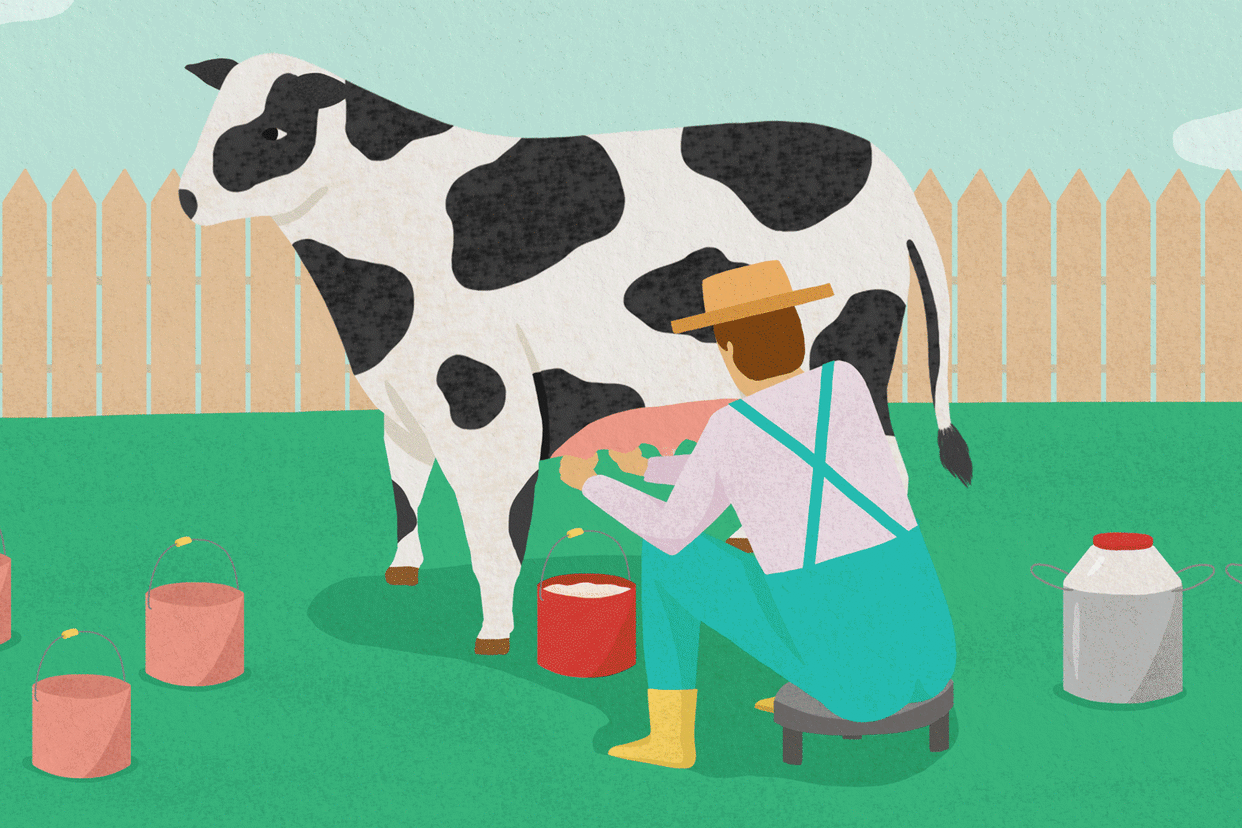Why You Should Get to Know Your Local Farmer

Yeji Kim
From both a quality and convenience perspective, there is absolutely nothing wrong with buying fresh food from a supermarket. Keeping the fridge and pantry stocked plus planning and prepping your family's meals? That's a full-time job. But when you have the opportunity to buy your corn from a farmers' market or pick up milk from a farm stand, something truly magical happens: You can talk to your farmer. Suddenly, you have a window into how the food you feed yourself and your family was made.
Due north of New York City, Hawthorne Valley Farm grows vegetables, crafts products like bread and jam, and makes yogurt, milk, and cheese. It uses biodynamic farming, a famously rigorous method that goes "beyond organic" in its environmental considerations. Co-manager Spencer Fenniman calls the farm, mostly grass, a "photosynthesis factory." His farm uses cover-cropping and composting, aiming to "build organic matter in soil," he says.
These are thoughtful farming methods that help protect the environment. Excellent news, seeing as the EPA says that agriculture causes 10 percent of U.S. greenhouse gas emissions. Some farming methods, especially those used by larger farmers, deprioritize climate. They may employ monocropping, synthetic fertilizers, or animal concentration. Meanwhile, most smaller farms are far more considerate of the impact that farming has on the environment.
If you are hoping to connect more with where your food comes from and how products are made, a great starting place is doing research on your favorite food brands and reading the labels on their packaging. And when buying from smaller suppliers, you can know your farmer by shopping at farmers' markets, farm stands, and on-farm stores. Meeting your farmer allows you to learn, ask questions, and know that the apples are spray-free, or that the dairy cows grazed on pasture.
Eating Local Is Important, but Not for the Reasons You Think
There is a common misunderstanding that eating local is a major way to limit your carbon "food-print" by shortening food miles. Food miles refer to the distance food travels from source to consumption. Often, food travel thousands. Think of European imports, blueberries grown in South America, or Alaskan salmon. Fossil fuels power vehicles that transport food. Many folks believe that eating locally cuts these fuel-burning emissions, thereby lowering one's carbon footprint.
This may be true, but not to the extent people think. The reason? Eighty-three percent of food's carbon footprint comes from production. For most foods, transportation makes up just 10 percent of emissions. "You want to reduce the carbon footprint of your food?" reads a One World Data report. "Focus on what you eat, not whether your food is local ...What you eat is far more important than where your food traveled from."
Buying from local farmers brings clarity. "As a consumer, you get to learn a lot more about the food," says Hannah Fuller, a communications associate at the Farmers Market Coalition. "By chatting at the market, you might be able to learn about what they're doing and how they're creating sustainable systems."
When buying directly from a farmer, you can ask about methods that limit climate impact and regenerate the land, and support those who use climate-friendly methods. A Rare.org report confirms that "changes at the level of individuals, household, and communities are of profoundly greater importance than most people realize."
4 Ways to Connect With Your Local Farmer
Farmers' Markets
The beauty of the farmers’ market is that you can buy from—and meet—many different farmers in one place. You can go in without any firm idea of what you want to buy or cook that night, and walk out with some just-laid eggs, eye-popping purple cabbage, and new dinner plans. The best part? Whatever they're offering, chances are that it will be locally grown, in peak season, and farmed sustainably. And if you're unsure, just ask.
Farm Stands
Instead of having the farm come to you, you can go to the farm. (Hey, you’re probably due for some socially distant time outside the house.) Farm stands are on-site stores that offer products grown or made on the farm. Not all farms have them, so call ahead if you aren’t sure. There’s nothing like being able to see, right there on the tree, plant, or vine, exactly where your food comes from—and walking away with a few fresh bags of blueberries or sweet corn (yum).
Schedule a Family Farm Tour
Remember the glory days of going apple-picking as a child, and how wonderful it felt to walk around the orchard and see how the apples were grown? You can relive that experience year-round at many farms across the nation by scheduling a farm tour. Agro-tourism is larger than life, and we couldn't be more thrilled. To find which local farms will gladly show you around their land (and introduce little ones to their animals along the way!), check out Agrotourism World. Want to stay the night? We don't blame you—try Farm Stay USA for lodging options.
CSAs
A CSA, or community supported agriculture, is a farm subscription that gets you periodic produce—whatever the farm has in season. CSAs come in various sizes and frequencies. Many are weekly. Some have an option to add other products, like eggs or fish, into your regular box. CSAs are typically available for pickup at farmers’ markets, farms, and at a select few other destinations (depending on the individual CSA). To sign up for a CSA, contact a local farm and see if they offer one.
Sure, knowing your farmer and learning more about your food takes work. But if you have the resources, we promise you'll find value in the experience. Knowing farmers ties us more intimately to our planet, to places using holistic methods, to countryside where cows are grazing on smartly managed pastures. It's a beautiful way to support farms operating in ways that honor the planet, and to live our lives in ways that better benefit both.

